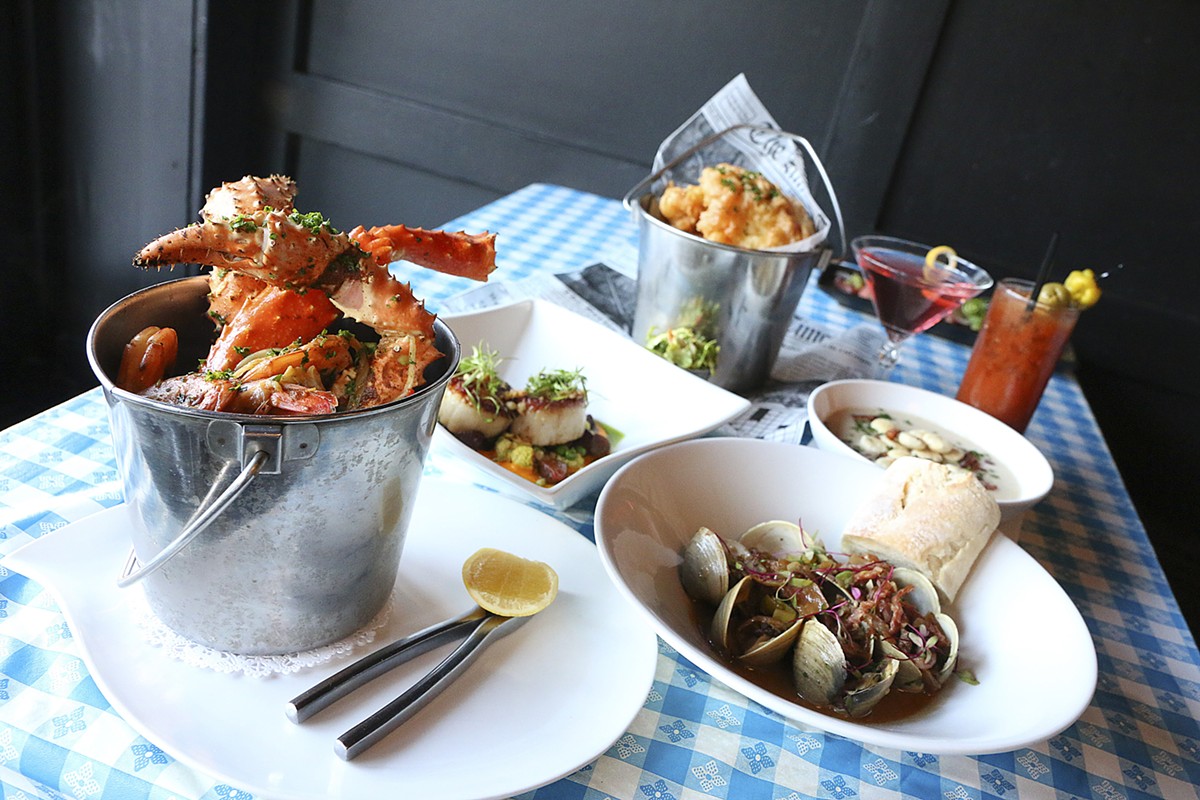If you haven't been to Tom's Oyster Bar in Royal Oak in a while you may be interested in learning about the changes that have taken place over the past several months. Gone are the flash-fried everything, chowders and bisques made from base, and gut-busting portions.
Now, under the leadership of executive chef Norman Fenton, who came to Tom's from the celebrated Bistro 82 in Royal Oak, line cooks are expected to chop the vegetables, not buy already-cut bags, make the soups fresh, and the portions, well, they're decidedly a lot smaller than what clientele of the 20-year staple may be accustomed to.
The makeover came about in August. As executive sous chef at Bistro 82, Fenton found himself in charge — and thrust into the spotlight — when the executive chef took an extended leave of absence. The resulting accolades led to several job offers when the chef returned.
Fenton says he could have taken his pick of other fine-dining establishments in metro Detroit, but he wanted a challenge. And that's precisely what he got at Tom's.
Tom's opened its doors in Royal Oak some two decades ago and, back in the '90s, became a hit for its familiar feeling and casual atmosphere, where one could get a decently priced drink, well-prepared seafood, and fresh oysters. The concept spread to three other locations: Grosse Pointe, Detroit, and Southfield. That growth though may have inadvertently been its undoing, as the menus became overly homogenized.
The other locations have since closed. In recent years, as Royal Oak has increasingly become a prime dining destination in metro Detroit, the Royal Oak outlet had lost its luster. Customers would complain of poorly executed dishes — the once-prized chowder, for example, became a gelatinous blob lacking flavor. The calamari was a chewy mess. And the tuna tartare, accompanied with a side of crackers, suffered from sloppy presentation.
"This place has been so stagnant for so long, so this was a chance for me to really stand out," Fenton says.
Fenton spent the first month cleaning up the back of the house, both with disinfectants and with his crew. He says he could tell the cooks in the kitchen were just clocking in time and collecting paychecks, with no aspirations of becoming chefs. Back at Bistro 82, Fenton recalls, the staff gathered around a table a full year before opening, fretting over every detail of the concept. If he was going to turn around Tom's, he needed a crew that had that same level of passion.
Within two weeks, 80 percent of the kitchen staff had walked out, replaced by a new team eager to execute a polished menu. The first thing Fenton did, before even starting to design the menu, was to get rid of the clam chowder and replace it with his own, made with corn, purple potato, chives, and thick crumbles of bacon. He transformed this otherwise unsung seafood restaurant staple into a simple, yet robustly flavored and promising starter.
He went on to revamp just about every other detail. Instead of heaping portions, he went with the still-trendy small plates concept, separating hot and cold appetizers, and a handful of larger entrées. Front-of-the-house staff had to be trained to retain longtime customers, many of whom were dismayed at the idea of having to order three or four shareable plates. Fenton says he went this route to keep costs down, while at the same time focusing on purchasing fresher ingredients.
Some of the standards remain on the menu, but they've been given the fine-dining treatment. The creamy crabmeat is panko-crusted, with peperonata relish, a grainy mustard, lemon, and pea tendril, giving a lighter, citrusy feel.
While Fenton doesn't proclaim to be a farm-to-table kind of chef, he notes that freshness is one of the details that can make or break a seafood restaurant. Instead of keeping fish frozen, as was the custom before his arrival, he strives to get the freshest catch. For his fish and chips, he uses battered cod to go with sides of crispy, malt-vinegar fries, gribiche, and a Brussels sprout slaw that's already a crowd-pleaser.
He's also introduced more unusual dishes one might be more likely to find at some of the trendier restaurants cropping up in Detroit. The foie gras steamed clams are one example: Prepared with parsley, onion brulee, prosciutto, garlic, and white wine, the unexpected combination of fatty duck with shellfish should compel any gourmet to give Tom's a second chance.
Sea scallops are often a hit or miss at most establishments because they're overcooked, but they are plump and seared at Tom's. They come two per serving, and are joined by curried carrots, golden raisins, cauliflower, peas, lemon oil, and cardamon-spiced walnuts, giving the diner a melody of complex flavors.
The saku tuna is another departure from the old seafood joint days, that when served with ponzu, wasabi roe, scallion, sesame seed, cucumber, and grapefruit, makes the dish a refreshing experience. And, in keeping with Detroit's love for our Canadian neighbors' poutine, Fenton makes his own seafood rendition, though it has yet to really catch on with diners.
The one thing Fenton has not touched is Tom's famous Spanish coffee, which makes for a delightful, warm, and boozy dessert.
Fenton acknowledges that his concept has resulted in the loss of some longtime customers who lamented the new menu in the first weeks and months of the transition. But, from what he's observing, he's been able to convert some long-timers into new loyalists, as well as attract a new generation of customers, which really was what he was looking for when he took on the takeover challenge.
Now see: 16 photos inside Tom’s Oyster Bar in Royal Oak


